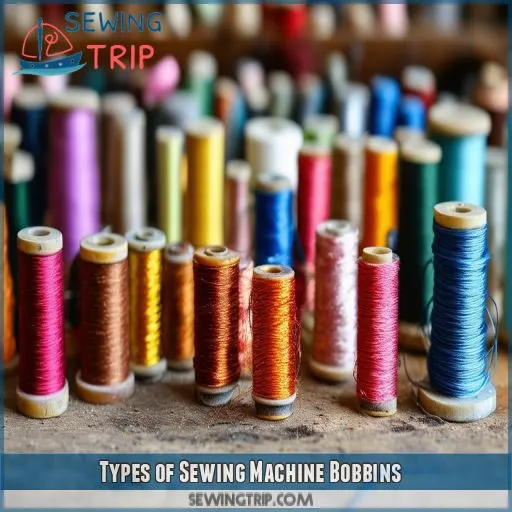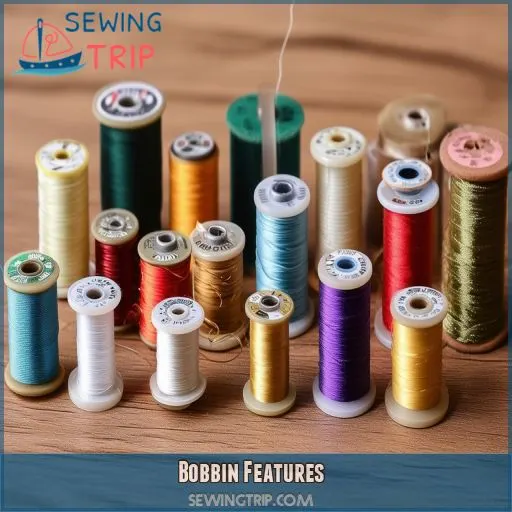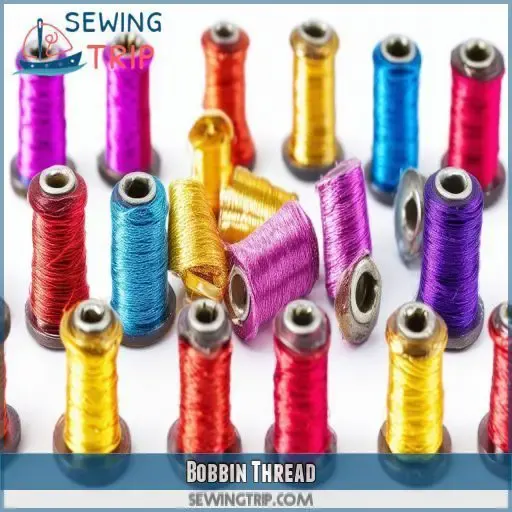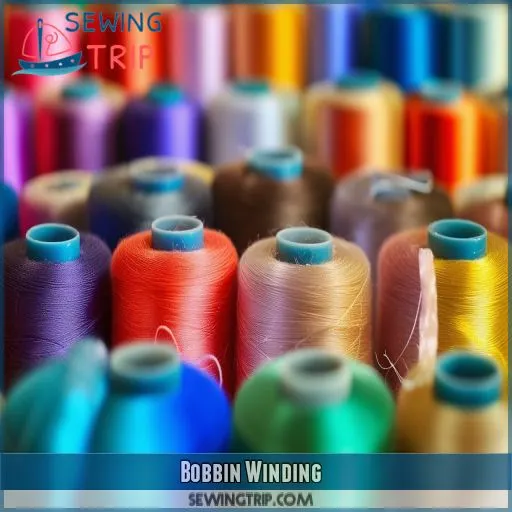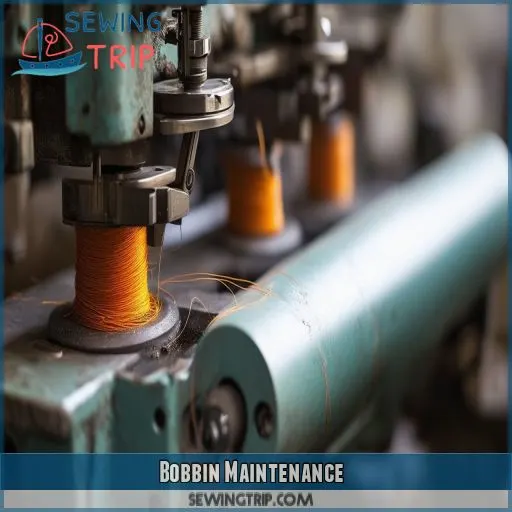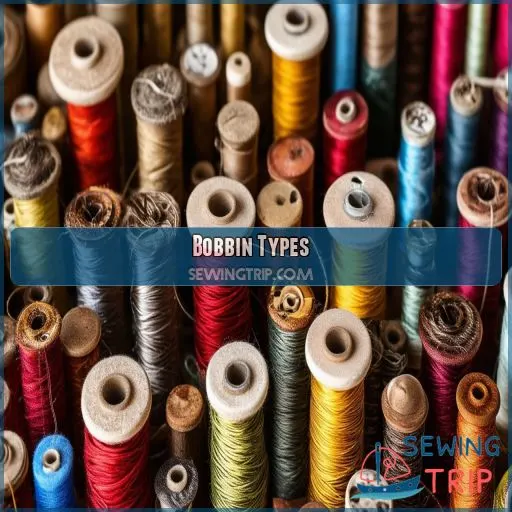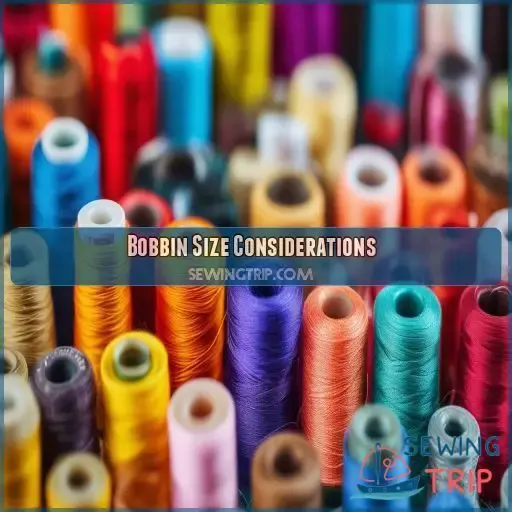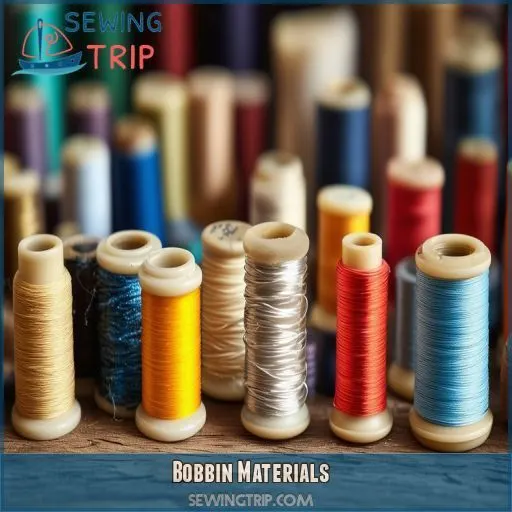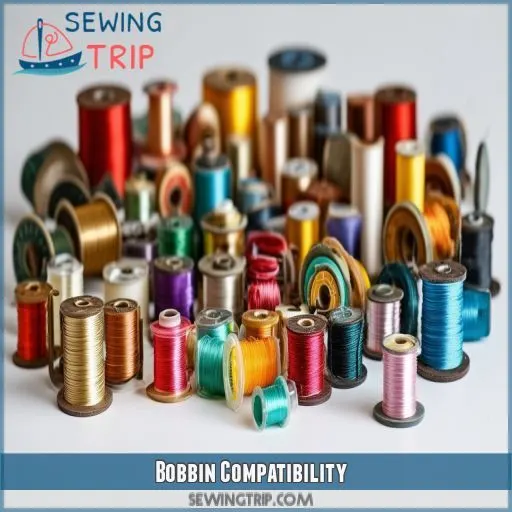This site is supported by our readers. We may earn a commission, at no cost to you, if you purchase through links.
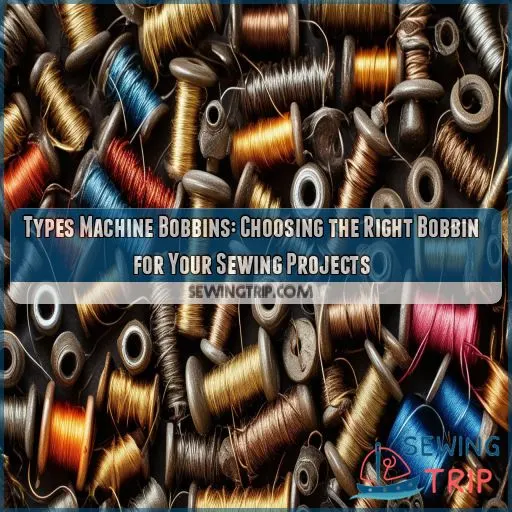
Bobbins are available in metal or aluminum, providing durability and lightweight options. Prewound bobbins are convenient and hold more thread.
Using the correct bobbin type is essential for seamless sewing and avoiding tension issues. Regular cleaning and maintenance will ensure your bobbins perform well.
Explore further to discover the secrets of impeccable stitching with the appropriate bobbin selection.
Table Of Contents
- Key Takeaways
- Types of Sewing Machine Bobbins
- Bobbin Features
- Bobbin Thread
- Bobbin Winding
- Bobbin Maintenance
- Bobbin Types
- Bobbin Size Considerations
- Bobbin Materials
- Bobbin Compatibility
- Incorrect Bobbin Size Can Cause Tension Issues
- Mismatched Sizes Lead to Skipped Stitches or Thread Breaks
- Proper Size Ensures Even Stitches and Smooth Seams
- Consistent Stitch Quality Maintained With Correct Bobbin Size
- Metal or Plastic Bobbins, Typically Interchangeable
- Some Machines May Have Specific Material Requirements
- Consult Machine Manual for Material Compatibility
- Incorrect Material Can Cause Bobbin Jamming or Damage
- Proper Material Ensures Smooth Bobbin Operation
- Frequently Asked Questions (FAQs)
- Conclusion
Key Takeaways
- Bobbins come in more varieties than ice cream! From Class 15 for home machines to L-style for longarm quilting, there’s a perfect match for every sewing setup. Just remember, one size doesn’t fit all – using the wrong bobbin is like trying to fit a square peg in a round hole!
- Pre-wound bobbins are the unsung heroes of the sewing world. They’re like having a personal assistant who preps your thread for you, saving time and holding up to 40% more thread. Talk about efficiency on a spool!
- Bobbin maintenance isn’t just a fancy term – it’s the secret sauce for smooth sewing. Regular cleaning and inspections are like giving your machine a spa day. Trust me, your future self will thank you when you’re not wrestling with tension issues mid-project.
- Don’t be afraid to think outside the bobbin! These little spools aren’t just for sewing. With a dash of creativity, they can transform into everything from funky jewelry to miniature planters. Who knew such a small object could have such big potential?
Types of Sewing Machine Bobbins
Selecting the appropriate bobbin for your sewing machine is essential for guaranteeing seamless operation and superior stitching. From the standard Class 15 bobbins employed in home machines to specialized L-style bobbins for longarm quilting and M-style bobbins for 10-needle embroidery, each type is designed for specific machines and purposes.
Class 15: Common for Home Machines
Class 15 bobbins are your go-to for home sewing machines. They offer:
- Consistency
- Ease of use
- Wide availability
- Ideal for home machines
- Various materials
L-style: Used in Longarm Quilting Machines
For longarm quilting machines, L-style bobbins are essential for accurate work. They enable proper tension adjustment and compatible thread handling, improving quilting efficiency and stitch quality.
| Feature | L-style Bobbins |
|---|---|
| Speed | High-speed compatible |
| Case Compatibility | Longarm machines |
| Winding Techniques | Even and tight |
| Bobbin Sizes | Standard L-size |
M-style: Found in 10-needle Embroidery Machines
M-style bobbins, used in 10-needle embroidery machines, provide ample bobbin thread capacity. Their size range is suitable for various embroidery machine compatibilities and guarantees accurate stitching.
Unique Bobbins: Required for Specific Machines
Unique bobbins are required for specific machines. Confirm bobbin compatibility by consulting your manual. Metal, aluminum, or factory-wound bobbins may fit uniquely designed bobbin cases.
Bobbin Features
Each sewing machine requires a specific bobbin style. Prewound bobbins offer convenience and contain 20-40% more thread, wound at high speeds by advanced machinery, while color-matching bobbin thread helps avoid tension issues.
Specific Bobbin Style Required for Each Sewing Machine
Each sewing machine requires a specific bobbin style. Verify:
- Proper bobbin sizes
- Correct bobbin materials
- Regular bobbin maintenance
- Verified bobbin compatibility
- Balanced bobbin tension
Prewound Bobbins Offer Convenience
You’ll appreciate the convenience of prewound bobbins, saving you time and effort in your sewing projects, with added thread storage benefits.
Prewound Bobbins Contain 20-40% More Thread
Prewound bobbins save time and thread, containing 20-40% more, offering exceptional convenience and quality. Their availability enhances efficiency and cost.
Advanced Machinery Winds Prewound Bobbins at High Speeds
Advanced machinery winds prewound bobbins at high speeds, ensuring tight, even layers for longer sewing runs, ideal for mass production.
Color-matching Bobbin Thread Helps Avoid Tension Issues
Color-matching bobbin thread helps balance thread tension, reducing tension issues. This practice guarantees seamless stitches and ideal fabric integration.
Bobbin Thread
Using color-matching bobbin thread is a preferred method for many sewists to avoid tension issues and achieve a more harmonious finish. It’s essential to balance the tension between the top and bobbin thread for smooth, even stitches.
Color-matching Bobbin Thread Preferred by Many Sewists
Using color-matching bobbin thread helps you achieve a flawless appearance and avoid tension issues. Here’s why:
- Bobbin color matches top thread, blending stitches.
- Thread compatibility improves stitch quality.
- Avoids tension issues and breakages.
- Fabric matching enhances overall aesthetics for ideal sewing results.
Top and Bobbin Thread Tension Should Be Balanced
Balancing bobbin tension with the top thread is key for stitch quality and smooth seams. If the bobbin tension is too tight or loose, you’ll encounter tension problems like uneven stitches or puckered fabric. Ensuring both threads are balanced prevents these issues, ensuring your sewing projects are flawless.
Bobbin Winding
Winding your bobbins properly is essential for smooth sewing and avoiding tension issues. Prewound bobbins offer convenience, but self-winding on your machine, ensuring even and tight winding, can be just as effective.
Prewound Bobbins Are Commercially Wound
Prewound bobbins offer benefits like high-quality thread, consistent tension, and time savings. They’re available in various sizes and reasonably priced.
- High thread quality
- Consistent tension
- Time savings
Self-winding Bobbins Can Be Done on the Sewing Machine
To self-wind bobbins on your machine, confirm bobbin compatibility, use proper winding techniques, adjust tension, select quality thread and matching colors.
Bobbins Should Be Wound Evenly and Tightly
Verify that your bobbin winding is uniform and taut for ideal bobbin tension. This aids in maintaining seamless operation within the bobbin case.
Loosely Wound Bobbins Can Cause Tension Problems
When bobbins are loosely wound, tension problems can arise. Loose winding affects bobbin tension, often leading to uneven stitches and frustration.
Proper Bobbin Winding Ensures Smooth Sewing
Ensuring smooth sewing means paying attention to bobbin winding.
- Maintain consistent bobbin speed.
- Use proper thread tension.
- Employ correct winding technique.
Bobbin Maintenance
To keep your sewing machine running smoothly, regularly clean your bobbins to remove lint and thread residue that can affect performance. Inspect bobbins for any damage or cracks, and replace them promptly to avoid sewing problems.
Bobbins Should Be Cleaned Regularly
After winding, proper bobbin maintenance is essential. Clean your bobbins to prevent lint removal and thread residue buildup, ensuring efficient performance maintenance by replacing any damaged bobbins.
Lint and Thread Residue Can Affect Bobbin Performance
Regular bobbin cleaning is vital. Remove lint and thread residue to protect bobbin durability and long-term performance. Proper bobbin storage assists in efficient thread management.
Inspect Bobbins for Damage or Cracks
Regular bobbin inspection is essential. Check for bobbin damage or cracks, as these can disrupt tension and overall bobbin performance. Keep your sewing smooth.
Replace Damaged Bobbins to Avoid Sewing Problems
If your bobbins show damage, replace them to avoid sewing issues. Remember:
- Inspect regularly for cracks.
- Verify bobbin compatibility.
- Prioritize bobbin quality.
- Extend bobbin lifespan.
Bobbin Types
Different projects and machines call for specific bobbin types like the Smart Bobbin (Style L), Big Bobbin (Style M), and pre-wound options. You’ll also find metal and aluminum bobbins, each with unique benefits based on your sewing needs.
Smart Bobbin (Style L)
The Smart Bobbin (Style L) provides accuracy, reducing tension difficulties and guaranteeing smooth sewing, especially crucial for precise quilting projects.
| Feature | Advantages | Compatibility |
|---|---|---|
| High precision | Reduces tension difficulties | Longarm quilting |
| Consistency | Guarantees smooth sewing | Various L-style |
| Durability | Lasts longer | Compatible machines |
| Easy integration | Hassle-free setup | Fit standard cases |
Big Bobbin (Style M)
The Big Bobbin (Style M) allows for longer sewing sessions due to its larger bobbin size, increased bobbin capacity, and excellent thread compatibility.
- Holds more thread
- Reduces bobbin changes
- Ideal for large projects
Metal Bobbins
Metal bobbins are durable and heavy, ideal with thick thread. However, they can be noisy and slightly more expensive.
| Aspect | Pros | Cons |
|---|---|---|
| Weight | Handles thick thread well | Heavier, more wear |
| Durability | Long-lasting | Can damage machine parts |
| Cost | Affordable to replace | Slightly higher than plastic |
| Availability | Widely available | Can be harder to find specific types |
| Noise | Strong durability | Can be noisy during use |
Aluminum Bobbins
Aluminum bobbins are lightweight, reducing backlashing. Popular choices for their durability:
- Reduces bobbin tension
- Color-matching bobbins
- Easy bobbin maintenance
- Prewound bobbins friendly
Pre-wound Bobbins
Prewound bobbins offer winding convenience, increased thread capacity, and precise color matching, making them an excellent choice among various bobbin types.
Bobbin Size Considerations
When choosing a bobbin size, consider the quilting style you’re aiming for—use a smart bobbin for detailed quilting and a big bobbin for overall designs. Bobbin sizes can be switched, but keep in mind the cost of parts needed for the change.
Choose Based on Quilting Style
When selecting bobbin size for your quilting style, consider the bobbin type. Prewound bobbins offer convenience, while larger sizes reduce constant bobbin changes during extensive projects.
Smart Bobbin for Detailed Quilting
For detailed quilting, the Smart Bobbin‘s smaller geometry guarantees precise thread tension, crucial for intricate quilting techniques and achieving high-quality stitches on varying fabric thicknesses.
Big Bobbin for Overall Designs
For overall designs, opt for Big Bobbin. With larger bobbin size, you’ll need fewer changes. It provides consistent bobbin tension and smooth bobbin thread flow.
Can Switch Bobbin Size for Cost of Parts
Switching bobbin sizes can save costs. Verify bobbin compatibility with your machine by considering:
- Bobbin cost
- Material substitution
- Size options
- Thread compatibility
- Machine requirements
Bobbin Materials
When selecting bobbin materials, consider your project needs. Metal bobbins are heavy and ideal for thick threads, while aluminum bobbins are lightweight and reduce backlashing for smoother sewing.
Metal Bobbins: Heavy, Work Well With Thick Thread
Metal bobbins are strong, durable bobbins, ideal for heavy thread and thick fabrics. Their weight guarantees stability and consistent performance.
Aluminum Bobbins: Light Weight, Reduce Backlashing
Aluminum bobbins are lightweight, reduce backlashing, and are both durable and affordable. They offer:
- Improved tension control
- Smooth operation
- Long-term use
Pre-wound Bobbins: Convenient, Limited Color Choice
You’ll appreciate pre-wound bobbins’ convenience, but limited color choices might hinder your creative vision, so consider machine compatibility and winding preferences.
Factory-wound Bobbins: Hold More Thread, Thinner Thread
Factory-wound bobbins boast higher thread capacity due to tighter winding, using thinner thread, making them ideal for extended sewing projects.
Magna-Glide Bobbins: Magnetic Core, Consistent Force
Magna-Glide bobbins have a magnetic core, ensuring consistent force and stable bobbin tension, ideal for precise longarm quilting.
Bobbin Compatibility
Choosing the correct bobbin size is essential to prevent tension issues and stitch quality problems. Additionally, the material composition of the bobbin should align with your machine’s requirements, ensuring smooth operation and avoiding damage or jamming.
Incorrect Bobbin Size Can Cause Tension Issues
Using the wrong bobbin size can throw off your machine’s tension. Check compatibility!
Mismatched Sizes Lead to Skipped Stitches or Thread Breaks
You’ll face more than tension issues with mismatched bobbin sizes. Here’s why:
- Skipped stitches
- Thread breaks
- Poor material compatibility
Proper Size Ensures Even Stitches and Smooth Seams
Choosing the right bobbin size guarantees your stitches remain even and seams stay smooth.
Consistent Stitch Quality Maintained With Correct Bobbin Size
Using the correct bobbin size guarantees consistent tension and stitch quality in your projects.
Metal or Plastic Bobbins, Typically Interchangeable
You’ll find metal and plastic bobbins are often interchangeable. Keep these points in mind:
- Bobbin size matters more than material
- Metal bobbins offer durability
- Plastic bobbins are lightweight
- Check your machine’s compatibility first
Some Machines May Have Specific Material Requirements
Your machine may require specific bobbin materials to prevent jamming and guarantee smooth operation.
Consult Machine Manual for Material Compatibility
Check your machine’s manual for the right bobbin material, shape, and finish.
Incorrect Material Can Cause Bobbin Jamming or Damage
Using the wrong bobbin material can wreak havoc on your sewing machine’s performance.
- Plastic bobbins in metal-only machines
- Metal bobbins causing excessive wear
- Incompatible materials leading to thread tension issues
- Incorrect bobbin size jamming the machine
- Non-manufacturer-approved materials risking damage
Proper Material Ensures Smooth Bobbin Operation
| Material | Compatibility | Maintenance |
|---|---|---|
| Metal | Durable | Easy clean |
| Plastic | Lightweight | Replace often |
Choose compatible materials to prevent damage and guarantee satisfactory performance.
Frequently Asked Questions (FAQs)
What are the different types of bobbins?
You’ll encounter various bobbin types: Class 15 for home machines, L-style for longarm quilting, and M-style for embroidery. There’s also metal, aluminum, and pre-wound options. Each type serves specific purposes, so choose wisely based on your machine’s requirements.
Do all bobbins fit all machines?
One size fits all" doesn’t apply to bobbins. You’ll find they’re not universal. Different machines require specific bobbin types. It’s paramount you match the bobbin to your machine for smooth sewing. Always consult your manual for compatibility.
Are Class L and Class 15 bobbins the same?
No, Class L and Class 15 bobbins aren’t the same. Class L is larger, used in longarm quilting machines, while Class 15 is common in home sewing machines. They’re not interchangeable, so you’ll need to use the correct type for your machine.
How do I identify my bobbins?
Check your machine’s manual for specific bobbin requirements. Measure your bobbin’s diameter and height, noting its shape and material. Compare these details with standard bobbin types or consult a sewing store for expert identification. You’ll find the perfect match!
Can bobbins be recycled or repurposed?
While some may think bobbins are disposable, you can actually recycle or repurpose them. Clean plastic bobbins can be recycled with other plastics. Metal ones are recyclable too. You can also repurpose bobbins for craft projects or small storage solutions.
Are there biodegradable or eco-friendly bobbin options?
You’ll find eco-friendly options like biodegradable plastic bobbins made from plant-based materials. Some manufacturers offer recycled plastic bobbins too. While not widespread, these alternatives are gaining traction as the sewing industry embraces sustainability. Check with your machine’s manufacturer for compatibility.
How long does a typical bobbin last?
You’ll find that a typical bobbin’s lifespan varies based on usage and care. With proper maintenance, it can last for years. However, if you’re sewing frequently, you might need to replace it every few months for desirable performance.
Can bobbins be used for non-sewing craft projects?
Bobbins aren’t just for sewing. They’re great for crafting jewelry, making miniature wreaths, or creating unique wind chimes. You can even use them as tiny spools for organizing embroidery floss or thin ribbons.
Are there vintage or antique bobbins still usable today?
Yes, you’ll find many vintage bobbins still usable today. They’re often compatible with modern machines, especially if they’re metal. Just make sure they fit your bobbin case and don’t have damage. They’re great for collectors, too!
Conclusion
As you navigate the vast selection of sewing machine bobbins, remember that selecting the appropriate type is paramount to creating the perfect foundation for your creative endeavors. Whether you opt for Class 15, L-style, or M-style bobbins, compatibility with your machine is essential.
Consider the material options, including metal or aluminum, and the convenience of prewound bobbins shouldn’t be overlooked.
Regular maintenance and proper winding techniques will guarantee the smooth execution of your projects.

